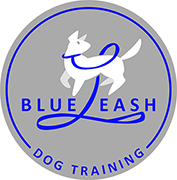Does my dog trust me?
Your instinct is to say yes, of course! I would never hurt them and they know that. But whether or not you would hurt your dog isn't really the question. Does your dog trust you to handle any situation? If your dog barks at other dogs on-leash, guards things, or gets nervous when someone approaches them, they don't view you as in control. Dogs with owners they trust are able to relax in unfamiliar settings, because they know you won't let anything bad happen to them. If that's you, great job! If you're realizing this could be the root of your dog's anxiety, good news! You’re more than halfway to fixing it because you ARE already in control and you’ve identified the problem.
Act like nothing bad is going to happen
One of the most effective ways to show your dog that you are in control is to act like you are! This includes relaxing your shoulders, walking with confidence, and going into situations you know may set off your dog without tensing up the leash or displaying any sort of anxiety yourself. If you cower or seem anxious, that's a sure sign to your dog that you lack control and it's up to them to protect you and themselves. If your dog starts acting up, address it and walk on with confidence as if nothing happened. You will blow your dog's mind and they will be so relieved to just follow instead of having to worry.
Use your body to block stressors when necessary
Being your dog's leader may require you to actually protect them from (harmless, but) distressing instigators like children or eager strangers. It can be hard to find it in yourself to stop people from reaching for your dog, but you owe it to your dog to only allow welcomed attention into your dog's space. Humans are huge compared to dogs, especially small ones! It's no wonder some dogs react defensively when trapped on the leash while a giant shadow comes over them. Move your body between your dog and the agitator without moving your dog or putting any tension on the leash. Firmly say, "Sorry, my dog isn't comfortable being approached that way." Lead them to approach your dog in a way your dog feels okay about. Ask them to wait for your dog enter their space when your dog is ready (rather than letting them enter your dog's space) or don't let them approach at all. Not all dogs are comfortable being touched by strangers and that's okay. Your dog will be so relieved to know that as long as they're with you, they are safe from uninvited encounters. Some insecure dogs who would never have let a stranger touch them will often start opening up once they feel more secure with you, knowing they can retreat to your space if they begin to feel uncomfortable again.
Create boundaries at home
You can show your dog that you're in control by setting and enforcing boundaries at home. Not only does this add enormous convenience to your homelife (dog doesn't push their way through open doors, swipe food from counters, or jump on you on the couch uninvited) but it shows your dog that you have control of the space. If you're in control of space, that shows them that you're a leader and that they don't have to manage it. Instead of barking at the mail carrier, they can feel safe and relax! This one is a bit harder to describe in writing since everyone's home and situation is different, but keep an eye out for our Cultivating Calm Workshops on our Events Page or schedule a Private Lesson any time!
If you have more questions about this, don't hesitate to schedule a free phone consultation with Amit the trainer! Your dog and situation are unique, he can help identify actions that will be most effective for you and your dog.
